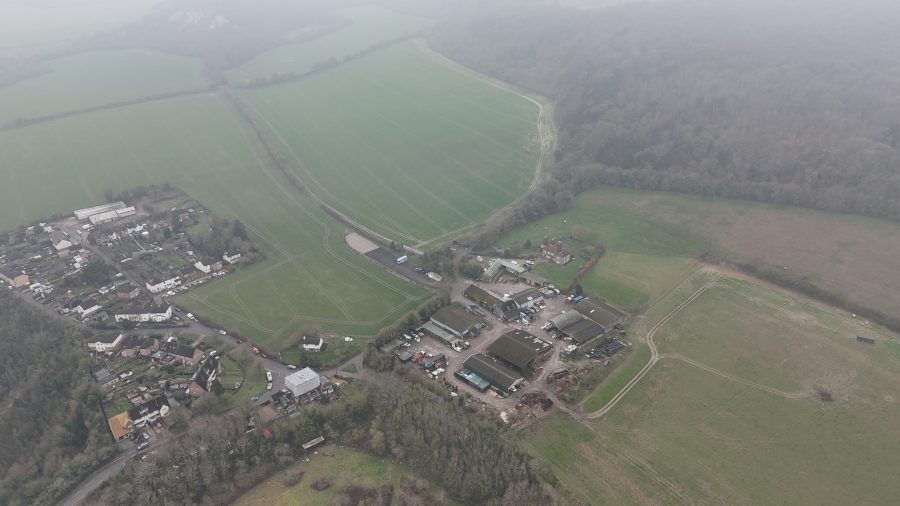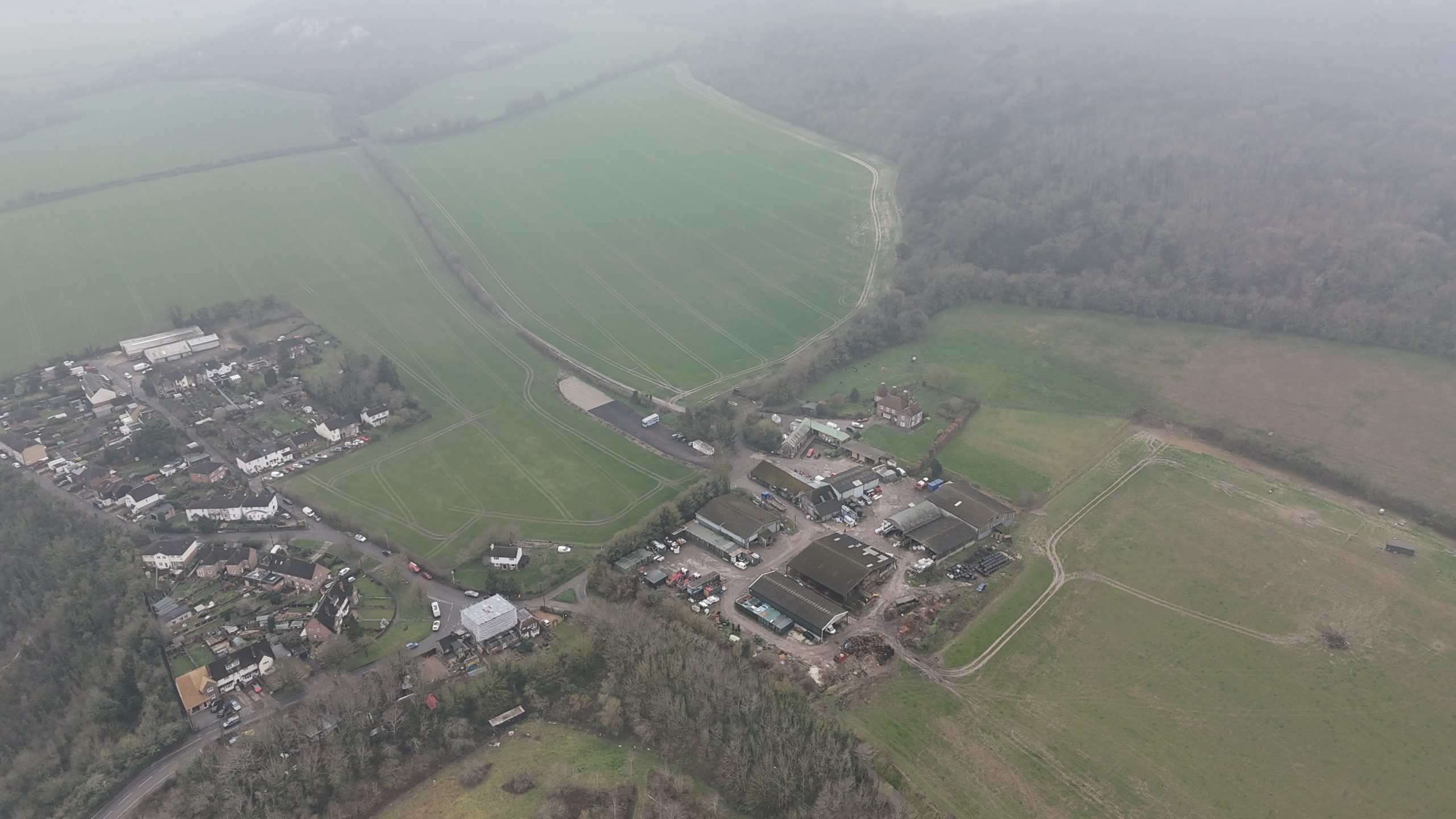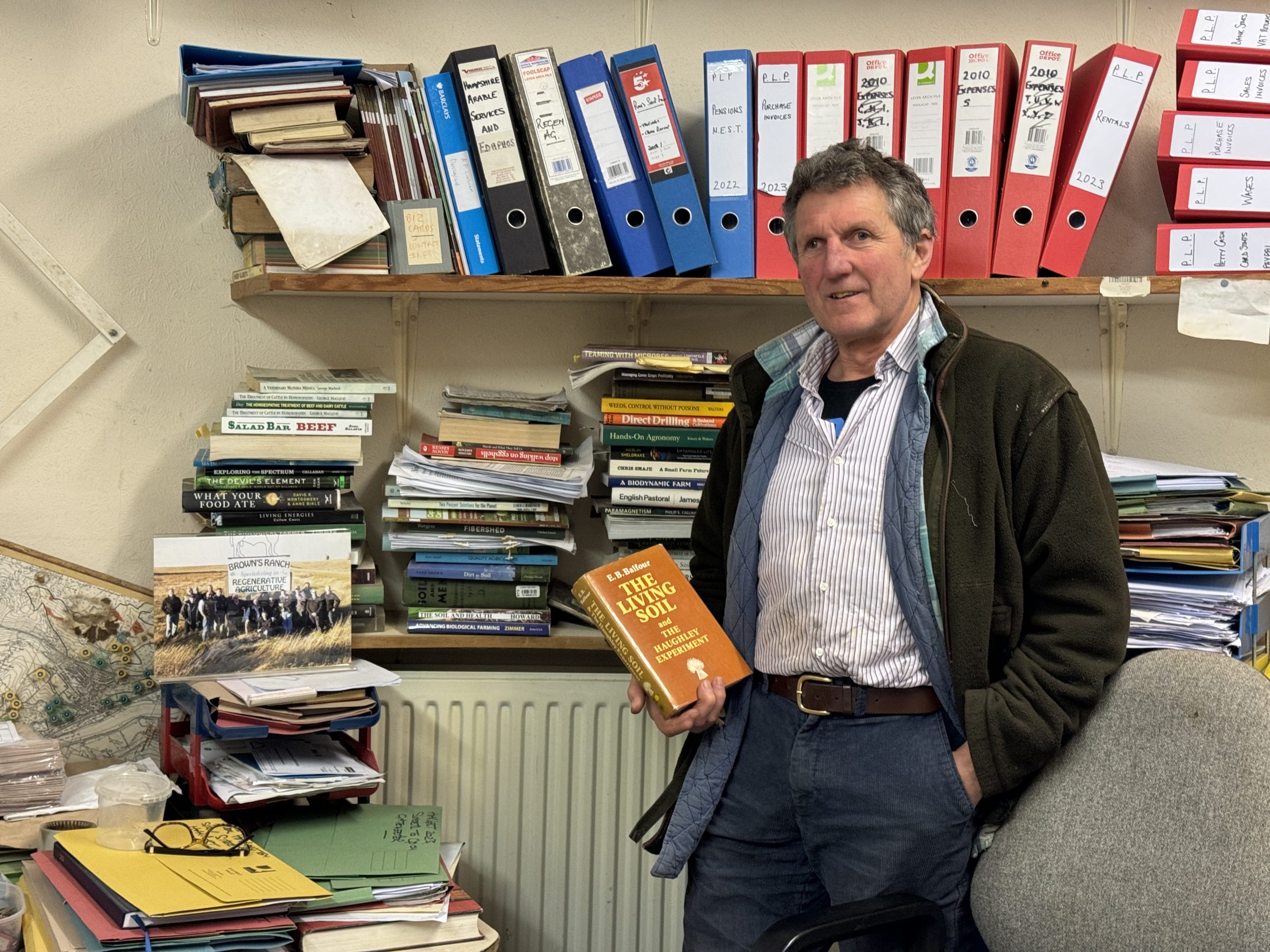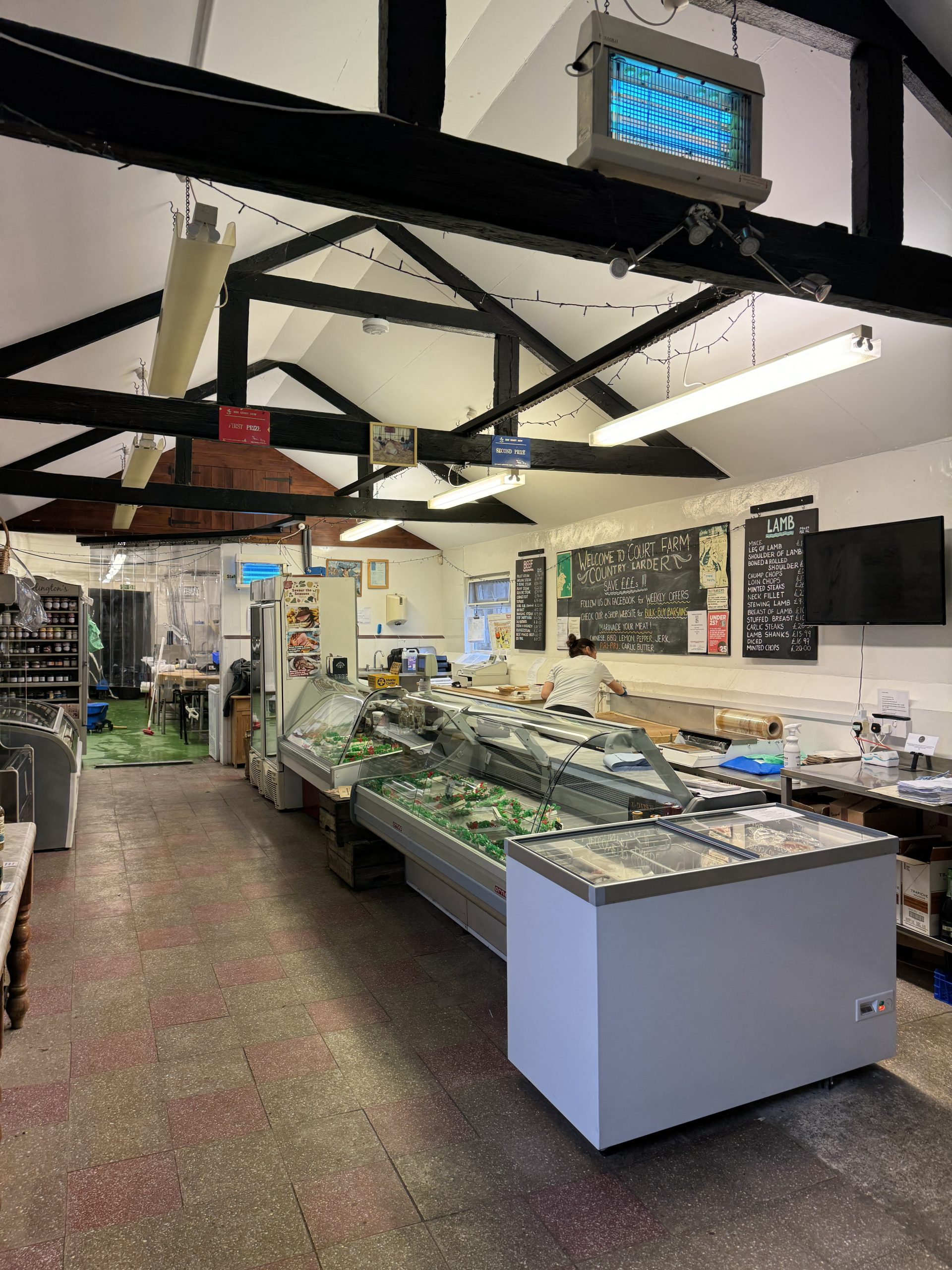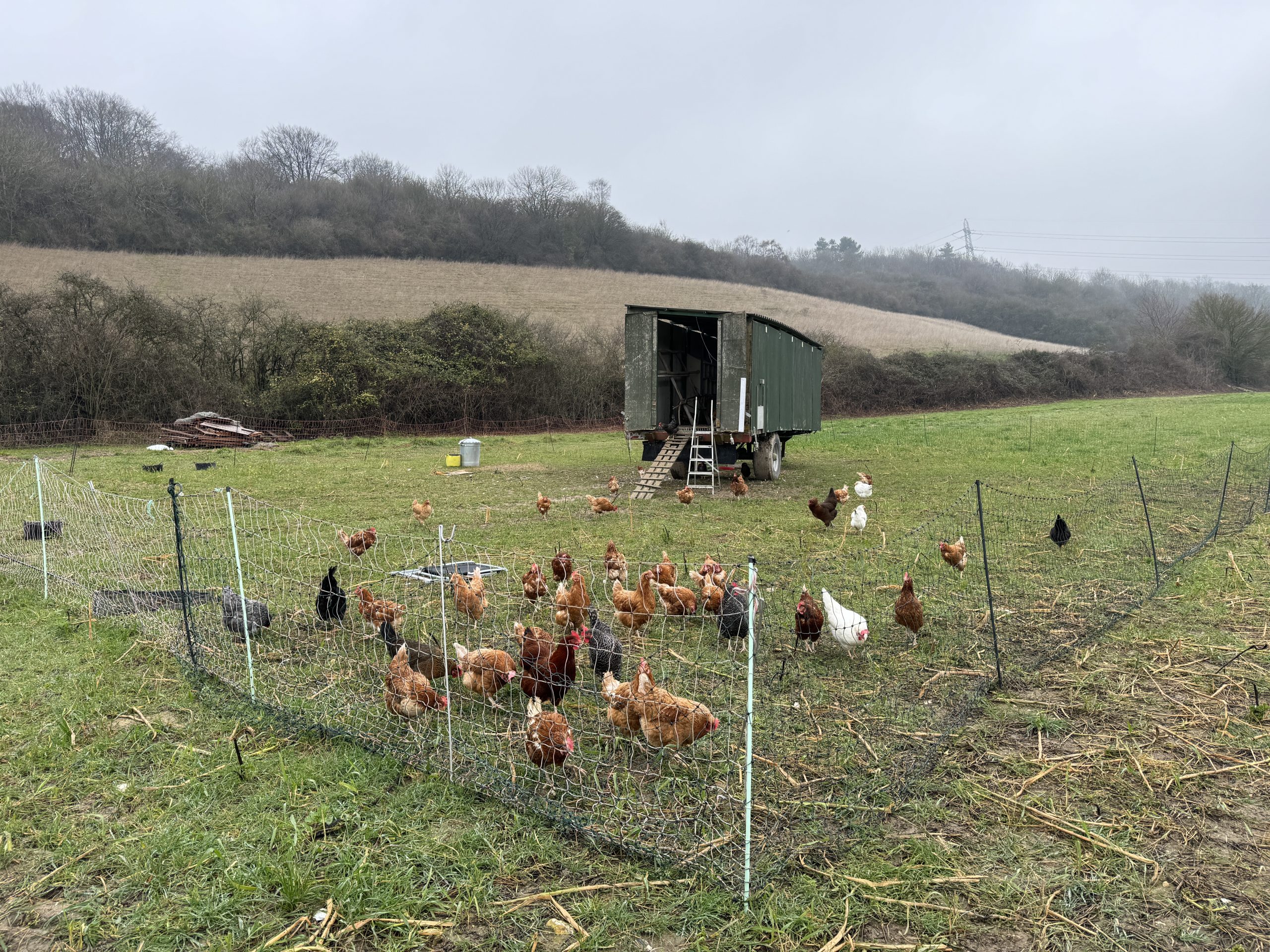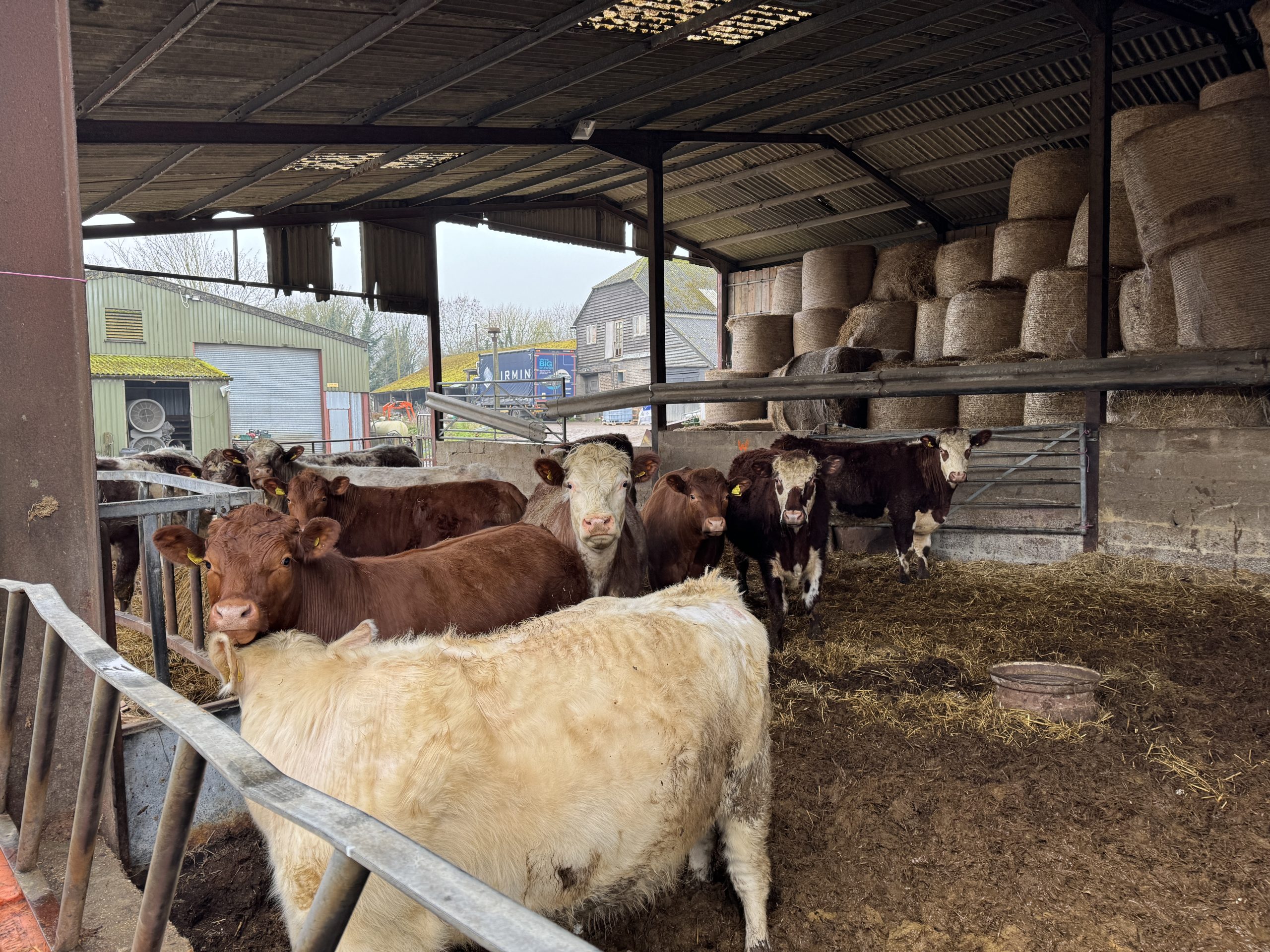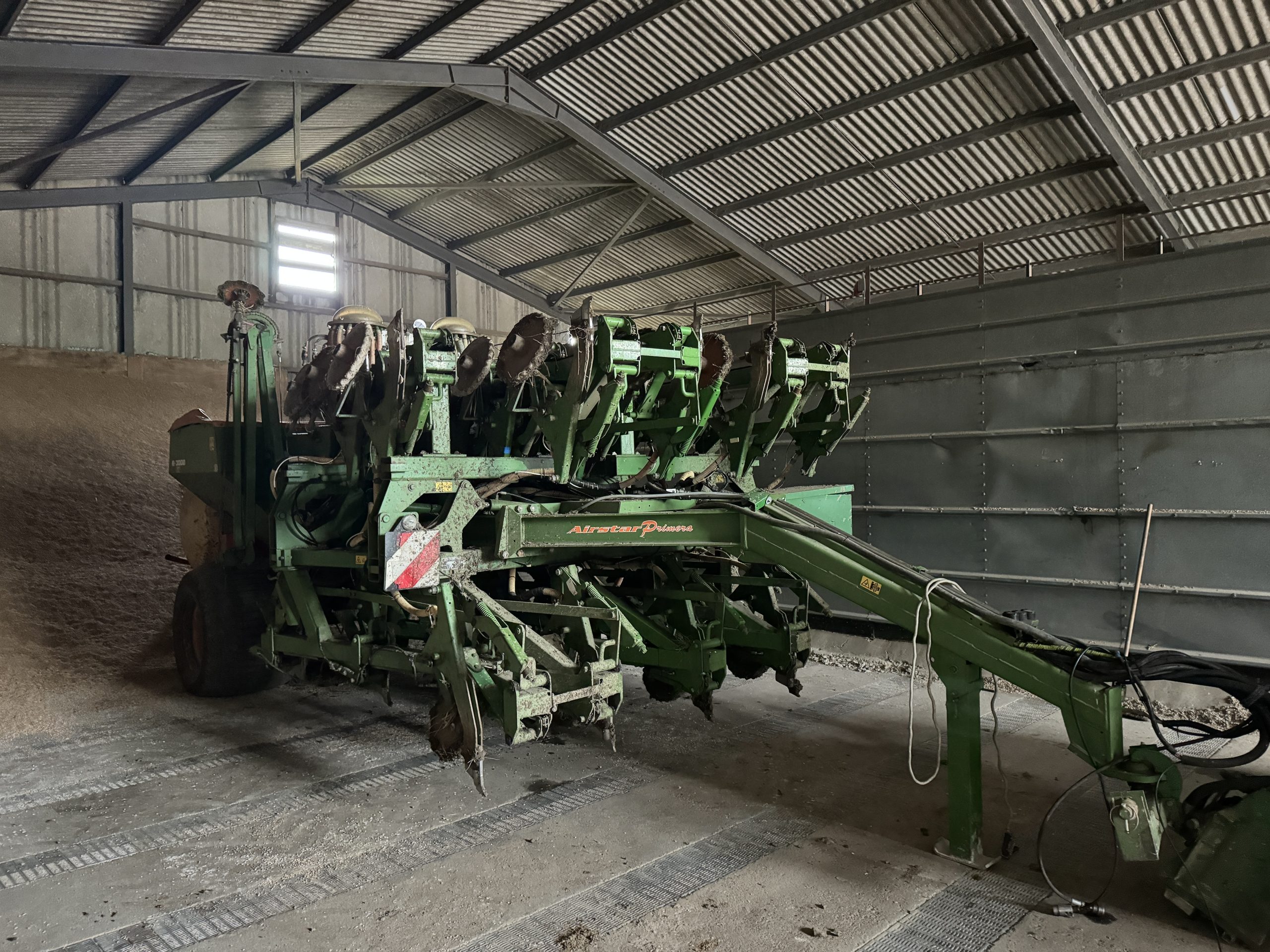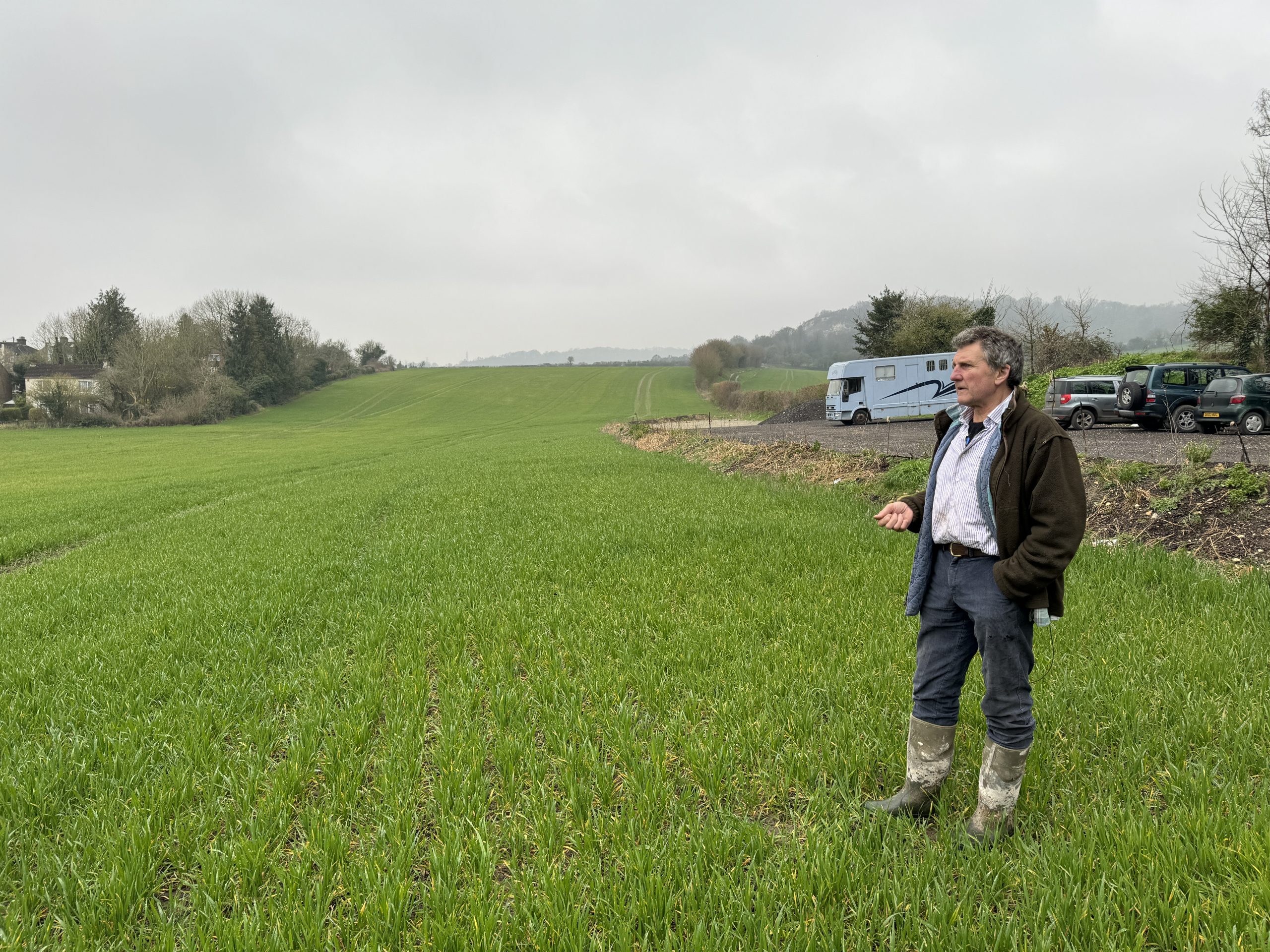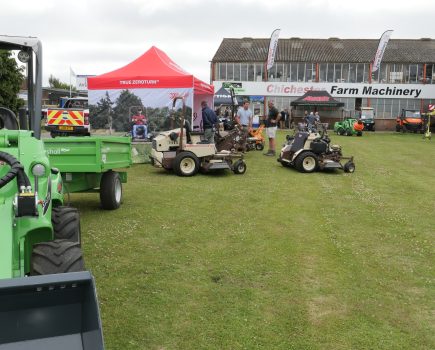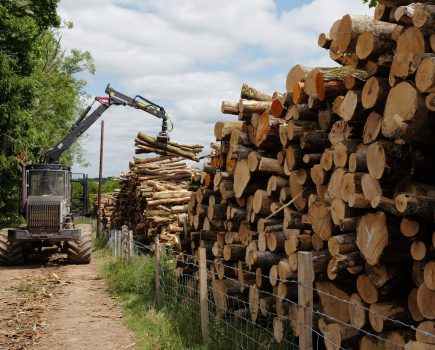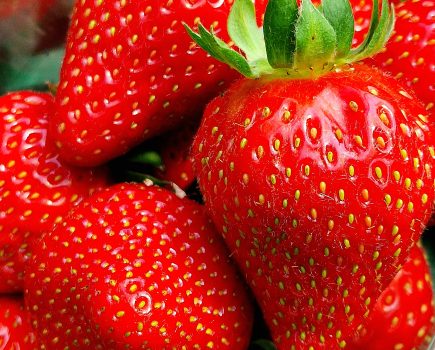This month Nigel Akehurst visits Andrew Lingham at Court Farm in Upper Halling, near Rochester in Kent, to find out more about his natural systems-based approach to mixed farming and creating a regenerative food hub on the farm.
Arriving at Court Farm, situated at the foot of the North Downs in Upper Halling, I notice the black sign advertising the farm as a “regenerative food hub” in a modern typeface with little icons.
I follow the drive and park up in a large, newly created parking area below the main yard. It’s Monday, so the farm shop and bakery are shut, but it’s still a hive of activity, with staff busy inside. There’s a lawn mowing business with ride on mowers lined up outside, and a brewery and tap room housed inside a large barn.
Behind the yard I spot the old brick farmhouse, flanked by a traditional oast house. The door is open, and I can hear Andrew chatting away on the phone. He finishes his call and invites me in for a cuppa and a chat.
Sat in his round office, I can’t help but marvel at the collection of farming books piled up on the shelf behind his desk.
“I’ve read most of them,” he said. A self-confessed regenerative farming nerd, Andrew is passionate about natural farming systems and improving soil health.
Sipping my tea, I ask him if he has a favourite book in his collection? He replies with: “For the Love of Soil by Nicole Masters”, a book he says is down to earth and has lots of relatable farmer case studies.
Another book he recommends is The Living Soil written in 1943 by Lady Eve Balfour, a British farmer, educator and founding figure in the organic movement.
History
The Linghams have been tenant farmers at Court Farm for four generations, tracing their history there back to 1871, said Andrew. After studying at Seale Hayne and stints in the USA, Australia and New Zealand, Andrew returned to the family farm in 1990.
In his early twenties he experienced a few health issues and at one point weighed around 10 stones, he said. This prompted him to start reading up on gut health and alternative medicines. Thankfully a combination of improved diet, acupuncture and homeopathic remedies helped him to recover.
It was this experience that led him to start questioning some of the received wisdom and conventional tools promoted by ‘Big Ag’. He began reading up on soil health and trialling more natural processes on the farm, including homeopathic remedies on his livestock.
Adding value was another priority for Andrew, who realised that generating an income for two families on around 600 acres of mainly grade 3 chalky soils would be a tall order.
Venison business and selling meat direct
During the early to mid-nineties, Andrew tried rearing red deer on the farm. He ran an operation that finished up to 100 deer annually and marketed the meat at various country shows, spending quite a bit of time “on the road”.
He also began selling their beef and lamb to a local butcher. Realising he could make a premium by selling the meat himself, he began marketing beef, lamb and venison boxes to the local community.
From the mid-nineties onwards he started selling direct from the farm gate, opening twice weekly for three hours on Wednesdays and Saturdays.
Word of mouth recommendations helped the business grow and Andrew decided that opening a farm shop and butchery would be a good idea. He took up the offer of 25% grant funding from the South East Economic Development Agency (SEEDA) to convert a redundant farm building, and opened to the public in 2002.
Farm shop and Farmers Markets
Over the past 20-plus years, the farm shop has gone from strength to strength, winning the Best Butcher of the Year and Food and Farming Landscape Taste of Kent awards in 2014. Andrew said that apart from a website (www.courtfarmbutchers.com) they do little advertising, attributing the growth to word of mouth. The business now employs a team of seven part time and full-time staff, including four butchers.
As well as selling their own Pasture for Life (PfL)-certified beef, lamb and free-range eggs, they sell locally sourced free-range chicken and pork and make their own pies, pasties, sausage rolls and ready meals. They also sell a wide range of local preserves, sauces, speciality cheeses, flour, apple juice, beer, ice cream and local fruit and veg from David Catt & Sons.
Sales rocketed during the pandemic, said Andrew, and after gaining planning permission he was able to convert some of the other redundant farm buildings in the yard to create a regenerative food hub.
The meat is also sold at two London farmers’ markets, a weekly market held in Blackheath and a fortnightly market held in Woolwich. They previously attended several monthly markets but found more frequent markets to be a “better bet” as “you get into people’s buying patterns”, he commented.
To this end, Andrew has recently obtained planning permission to run a fortnightly farmers’ market at Court Farm on the first and third Thursday of each month (10am to 2pm), which he hopes to launch in the late spring or early summer.
The market will be run as a joint venture with Medway Street Angels, a charity that Andrew already supports with weekly donations of meat and unsold bread.
Regenerative Food Hub
In addition to the shop and butchery, the farm yard now includes an artisan bakery, brewery and tap room that moved into an old workshop building last spring.
Neither are his own businesses, he explained, but they both pay rent and help create a more local food system, something Andrew believes is the key to sorting out climate change.
Adding to the food hub will be an on-site mill, producing artisan flour from his own heritage wheat. Andrew has already purchased an £8,000 stone mill from Austria, which he showed me in an old farm building, currently being made food safe. Once ready, later this year, he plans to make and sell his flour to the on-site bakery and other local artisan bakers.
In addition to the cluster of food businesses, Andrew has several other small lets, including a lawn mowing business, and admitted the rental income is vital to keeping the farm going.
Regenerative Farming and SFI
Andrew stopped ploughing his soil in the late nineties, moving to min tilling before buying his first direct drill in 2008, a second-hand Amazone Airstar Primera which he still uses today. In 2012 he started growing cover crops in the autumn to keep a living root in the ground, a key principle of regenerative agriculture and improving soil biology. Shortly after that he began integrating livestock into the arable rotation, another vital contribution to building up soil organic matter, he explained.
He said his soils now have an organic matter ratio of between 4% and 8%, adding that he regretted not having taken a baseline. He estimates that they have at least doubled since he switched to regen ag.
Over the years, as soil health has improved, Andrew has managed to reduce his artificial nitrogen use by 60% and his glyphosate use by 40%. For last harvest he managed to grow his wheat and bean crops without using a fungicide. This has all come from increasing soil health and nutrient cycling to produce healthier plants that are much less reliant on conventional inputs.
He sees the Sustainable Farming Incentive (SFI) and cover crop options as a big opportunity to improve soil health, adding that he understood from the Rural Payments Agency that fewer than one in eight farmers had so far signed up. “Unless we take up all that’s been allocated to SFI, they’re going to take it away and redirect it,” he warned, calling on more farmers to sign up.
Explaining his enthusiasm for SFI on his own farm, he said SFI took out a lot of the risk of farming on grade three soils. “On our farm we now grow winter wheat and winter beans and the rest of it is SFI,” he said.
“We’ve taken out a lot of the high-risk spring break crops. The only break crops he grows now are for cover crop seed as he can see that becoming valuable. “So we’re growing millet and beans for cover crop seed for SFI,” he added.
To maximise the benefits, he thinks SFI should come with an educational package, including knowledge exchange with farmers working together in a local cluster group.
“A lot of what I’ve learned about regen ag in the past 20 years has come from farmer knowledge exchange; groups of us getting together and re-learning natural processes,” he said.
Currently Andrew is part of the PfL mentoring programme which is spreading knowledge and understanding of regen ag across the south eastern counties.
Pasture for Life Livestock
By 2013 Andrew had started to integrate livestock around the arable rotation. “I’m one of the founding members of Pasture for Life, having joined in 2015,” he said.
He sold his beef suckler herd in 2017, explaining that it was too much work and he had lost some summer grazing for his cows. He switched to buying in PfL beef stores and finishes them to go through the butcher’s shop.
Over the past two or three years, Andrew has started building a customer base of other butchers and farm shops that want PfL stock. He said he’s trying to make a premium on what they are doing and said they had recently started supplying the Priory Farm shop at Red Hill.
He currently supplies around 30 to 35 bullocks to the farm shop annually and is now looking to build up his stock numbers, with the aim of finishing between 80 and 100 bullocks a year.
Typically, he buys his store animals in at between 18 and 30 months. One of his PfL suppliers is John Cherry, of Groundswell fame, who sells Andrew his shorthorn and Hereford crosses. Often, they are over 30 months old and Andrew is able to put the last six to eight weeks of finish on them.
He also buys store lambs from Camilla Ashby on the Romney Marshes. Again, she is PfL registered, and they are Romney, which finish incredibly well, he said.
He runs the beef and sheep together as a flerd (flock and herd) and moves the two strands of electric fence every two to three days if it’s wet and every three to four days if it’s dry. “I’m very keen on looking at what the soil conditions are and at the overhead conditions,” he said, adding that the aim was not to poach the ground.
Heading out to see the cows and sheep grazing a winter cover crop, we visited a 100-acre field a short drive down the road. Despite being one of the wettest Februarys on record, there is plenty of green material and the ground looks in good shape. I point out to Andrew that the skylarks seem to approve of the habitat, too.
He admits they are lucky to be on chalk and explained that he plans to follow the winter cover crop with a Southern Water-funded spring/summer cover crop. This will be followed by winter wheat, he added.
As we leave the field, Andrew stops to show me his composting windrows. He says they take in wood chip and mix it with farm yard manure to produce a fine compost. In the future he plans to start producing bokashi, using a plastic sheet to seal the material and create anaerobic compost.
Alternative supplements and farm machinery
Back in the farm yard, we visit a group of finishers housed in a shed. Andrew is feeding them a 4kg per head ration of Lucerne nuts, in addition to ad lib silage. He generally houses his fat cattle to put the last bit of finish on them, before taking them to slaughter at Beredens Farm Meats in Romford.
To aid rumen health, Andrew provides access to a liquid fulvic and humic acid product for his cattle and pointed to the licks. He also recommends diatomaceous earth, seaweed and Himalayan rock salt, which he puts in a heavy metal wheel with a wooden base for the cattle to access as required.
He also shows me his collection of IBCs, all containing various organic and mineral supplements including fish hydrolase, which he adds when direct drilling.
Next, we head into the grain store to check out Andrew’s main tractor and two direct drills, both of which he managed to buy second hand and has customised over the years. He admitted his tractor, a Fendt 828 with 280 horse power, is perhaps a bit of overkill, but added that it can come in handy on some of their banky fields.
Succession
Andrew is optimistic about the future of his farming business. His two sons, Harry and Alex, have both gone into farming. They have both indicated that they want to come home, and so the challenge now is to make the business large enough to support everyone that depends on it. Andrew has an Agricultural Holdings Act (AHA) tenancy on Court Farm, which is owned by Tarmac, with two generations remaining.
Leaving the farm, I felt inspired and full of ideas to try out at home. I am also determined to add to my own collection of regenerative farming books and finally read For the Love of Soil.
Farm facts
- Mixed Farm
- Farming 800 acres
- 500 acres of arable cropping
- Rolling five-year average wheat yield is 8.2 tonnes per hectare
- 300 acres of grass, including Countryside Stewardship land
- Diversified farm buildings – regenerative food hub as well as industrial lets
- Started direct drilling in 2008
- Started cover cropping in 2012
- Part of Kent Downs AONB Cluster Group
- default
- Andrew Lingham
- Andrew Lingham in a field of winter wheat

